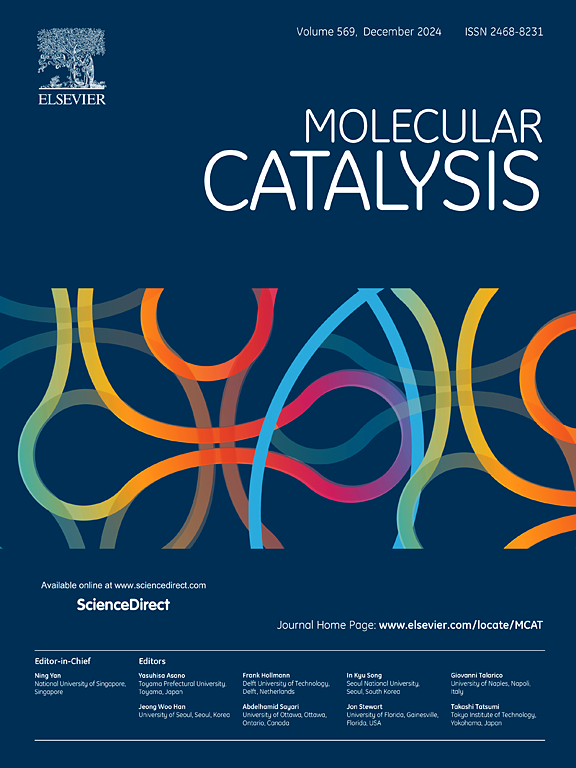室温共沉淀法制备磷酸镍包覆Zn0.4Cd0.6S纳米棒,增强光催化水裂解中H₂的析出
IF 3.9
2区 化学
Q2 CHEMISTRY, PHYSICAL
引用次数: 0
摘要
为了提高ZnS和CdS基光催化剂的产氢性能和光腐蚀性能,无需依赖铂、钌或金等贵金属,本研究优化了ZnxCd1-xS固溶体中Cd和Zn的摩尔比。所得的Zn0.4Cd0.6S纳米棒状固溶体具有优异的可见光催化活性。采用室温化学共沉淀法在Zn0.4Cd0.6S固溶体表面均匀沉积了非贵金属Ni3(PO4)2纳米薄层。这种改性不仅可以防止氧化光腐蚀,还可以促进光催化表面过程中水的氧化和还原,显著提高复合催化剂的稳定性和产氢性能。实验结果表明,Ni3(PO4)2助催化剂对Zn0.4Cd0.6S的性能改善明显大于传统Pt助催化剂。复合催化剂的产氢速率最高可达119.72 mmol·g⁻¹·h⁻,3小时后累计产氢340.33 mmol·g⁻¹。经过25小时的光催化循环实验,产氢速率保持在95.95 mmol·g⁻¹·h⁻,约为初始速率的80.14%。Z4C6S-5NPO的表观量子产率达到61.8%,在zncds基光催化剂中具有较高的应用价值。这些结果为开发低成本、高稳定、高效的复合光催化剂提供了有价值的见解。本文章由计算机程序翻译,如有差异,请以英文原文为准。

Room-temperature co-precipitation of nickel phosphate-coated Zn0.4Cd0.6S nanorods for enhanced photocatalytic H₂ evolution in water splitting
To enhance the hydrogen production performance and photo-corrosion resistance of ZnS and CdS based photocatalysts without relying on noble metals such as platinum, ruthenium, or gold, this study optimizes the molar ratio between Cd and Zn in ZnxCd1-xS solid solutions. The resulting Zn0.4Cd0.6S nanorod-shaped solid solutions exhibit superior visible-light photocatalytic activity. A non-precious metal Ni3(PO4)2 nano-thin layer is uniformly deposited onto the surface of the Zn0.4Cd0.6S solid solution via a room-temperature chemical co-precipitation method. This modification not only prevents oxidative photo-corrosion but also facilitates the oxidation and reduction of water during the photocatalytic surface process, significantly enhancing both the stability and hydrogen production performance of the composite catalyst. Experimental results demonstrate that the performance improvement of Zn0.4Cd0.6S by the Ni3(PO4)2 cocatalyst is markedly greater than that achieved with the traditional Pt cocatalyst. The maximum hydrogen production rate of the composite catalyst reaches 119.72 mmol·g⁻¹·h⁻¹, with an accumulated hydrogen production of 340.33 mmol·g⁻¹ after 3 hours. After 25 hours of photocatalytic cycling experiments, the hydrogen production rate remains at 95.95 mmol·g⁻¹·h⁻¹, approximately 80.14 % of the initial rate. The apparent quantum yield of Z4C6S-5NPO attains 61.8 %, with high value in ZnCdS-based photocatalysts. These results are promising and offer valuable insights for the development of low-cost, highly stable, and efficient composite photocatalysts.
求助全文
通过发布文献求助,成功后即可免费获取论文全文。
去求助
来源期刊

Molecular Catalysis
Chemical Engineering-Process Chemistry and Technology
CiteScore
6.90
自引率
10.90%
发文量
700
审稿时长
40 days
期刊介绍:
Molecular Catalysis publishes full papers that are original, rigorous, and scholarly contributions examining the molecular and atomic aspects of catalytic activation and reaction mechanisms. The fields covered are:
Heterogeneous catalysis including immobilized molecular catalysts
Homogeneous catalysis including organocatalysis, organometallic catalysis and biocatalysis
Photo- and electrochemistry
Theoretical aspects of catalysis analyzed by computational methods
 求助内容:
求助内容: 应助结果提醒方式:
应助结果提醒方式:


